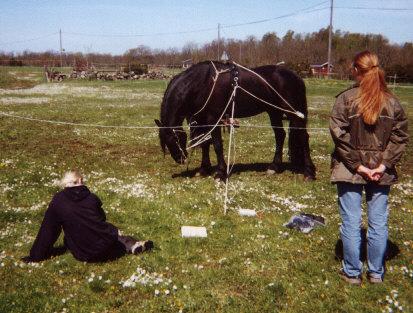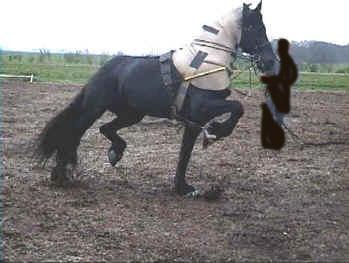
The way forward down or just downhill…?
In spring 2001 the Swedish assosiation for Friesian horses arranged a seminar in how to train your horse before a "Keuring"
Since I been organising clinics in Classical Riding for some years, I get in touch with a lot of "horse people" and we have discussed these training methods a lot, but I have never heard anyone defend this. Except trainers in Holland ! One of them explained "that the price was so high on a horse that was judge high in "Keuring" that it excused any method to get there"
The Swedish animal protection law consider this - abuse of animal- and against the Swedish law. The Dutch trainers are informed about this but there is still people that think this is a great method. Is it just us that's interested in Classical riding that is against this?
Below you can read a letter I received from one of the participants in this clinic.
" We where divided in two groups. It was the same horse that was on the lounge the whole time, because the trainer thought it was easier since it took a long time to put on all the geers. It also took a long time for the horse to get so tired that he accepted all this and started to trot normally. He was very stressed and as soon as a car passed by he got really scared and started to canter. The trainer just thought this was stupid. ( It might be that a horse with his head tied down to his knees cant see much of the surroundings so he really was scared)
After one and a half hour the groups changed places. The trainer talked for a while and put on more stuff. The horse was now dressed in chambong - pessoa harness - one other kind of side draw reins - about 400 grams of weights on all four legs and finally leather straps with metal rings around the fetlocks to make him lift higher.
"I could not make myself watch the hole time. At the end the horse looked like a Christmas tree with all the geers on. He might have stepped under a hoof length more after this torture but he carried all his weight on the front with his head under the belly line and totally restrained with all the different "aids". He could not ,in any way ,change his working position. On the trainers it seemed that in Holland ,this was considered "normal" training before Keuring. They also had all this equipment for sale.
" I don´t think I have missunderstod the method, what I have described is just what I have seen the trainers do. What I don´t understand is -who would like to have a horse that works with his weight on the front with his nose way "behind the bit"? It´s very hard to train a horse in a correct outline after he once learned to overbend his neck and withdraw from the bit. In an unexperienced persons hands this type of traing could lead to catastrophic results".
(remarks in a parenthesis is my own) On the same clinic the Dutch trainers showed how to groom a horse for "keuring".The hair on the front of and under the belly was burnt of with a candle! The trainer warned about burning inside the ears of the horse since they, due to the earwax , easily cought fire!! I thought that every normaly equipped "horse person" understod that there is a reason why horses have protective hair in their ears.If you don´t think your horse is black enough, or have white markings, you can always order some black colouring schampo.
Since one off the instructors is an approved FPS judge I contacted FPS asking their opinion of these training methods and if this is something they recommend. FPS never answered my letter. I have gotten some answers from Dutch trainers. From what they are saying you can understand that almost anything is accepted as long as it results in higher scores = higher price for the horse...
The fact that FPS and the Swedish Friesian assosiation approve of these training methods for horses to be shown for breeding evaluation can be disatrous for the future.
This is methods commonly used in Holland. This is also methods this trainer proudly shows - it makes you wonder what they don´t show

The horse on the top is an approved stallion (later taken out of the studb.)
The horse above is a young stallion (2,5 years old) in training for the stallion show 2004.
The trainer explains that this way you can train muscels you can never train in a "natural" way...
It makes you wonder if it´s still possible to train a horse in a "normal" way and still get a good judgement at the FPS keuring.
This is also what they select their breeding material from...
http://www.nobynas.se/articles.htm

